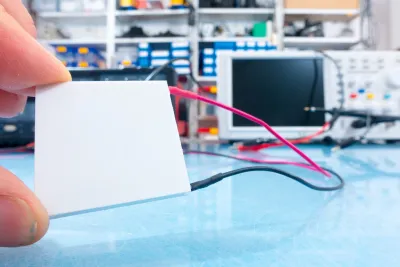Heat from industrial installations and buildings can be captured to create renewable electricity.

Scientists are working to develop devices that can harness waste heat from buildings and industrial uses to produce energy. As Muhammad Muddasar explains in The Conversation, most existing thermoelectric materials used to make such devices contain cadmium, lead, or mercury, toxic and often expensive substances.
Muddasar and other researchers at the University of Limerick and the University of Valencia have discovered a way to use wood-derived materials to convert waste heat. “This approach not only enhances energy efficiency, but also redefines how we view everyday materials as essential components of sustainable energy solutions.”
The research team used lignin, a byproduct of the paper industry, to convert low-temperature waste heat into electricity. “Since around 66% of industrial waste heat falls within this temperature range, this innovation presents a significant opportunity for eco-friendly energy solutions.”
In addition to capturing energy, thermoelectricity also requires storage solutions. Lignin-based porous carbon can also be used in supercapacitors to store energy. According to Muddasar, “This technology could find use in various settings, from providing power in remote areas to powering sensors and devices in everyday applications.”
FULL STORY: How waste heat could be captured and converted into green energy

National Parks Layoffs Will Cause Communities to Lose Billions
Thousands of essential park workers were laid off this week, just before the busy spring break season.

Retro-silient?: America’s First “Eco-burb,” The Woodlands Turns 50
A master-planned community north of Houston offers lessons on green infrastructure and resilient design, but falls short of its founder’s lofty affordability and walkability goals.

Delivering for America Plan Will Downgrade Mail Service in at Least 49.5 Percent of Zip Codes
Republican and Democrat lawmakers criticize the plan for its disproportionate negative impact on rural communities.

Test News Post 1
This is a summary

Test News Headline 46
Test for the image on the front page.

Balancing Bombs and Butterflies: How the National Guard Protects a Rare Species
The National Guard at Fort Indiantown Gap uses GIS technology and land management strategies to balance military training with conservation efforts, ensuring the survival of the rare eastern regal fritillary butterfly.
Urban Design for Planners 1: Software Tools
This six-course series explores essential urban design concepts using open source software and equips planners with the tools they need to participate fully in the urban design process.
Planning for Universal Design
Learn the tools for implementing Universal Design in planning regulations.
EMC Planning Group, Inc.
Planetizen
Planetizen
Mpact (formerly Rail~Volution)
Great Falls Development Authority, Inc.
HUDs Office of Policy Development and Research
NYU Wagner Graduate School of Public Service





























